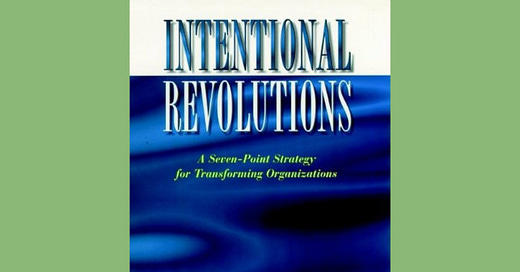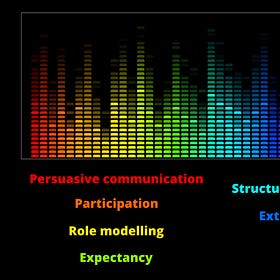Influential Thinkers: Joan Lancourt
Deep insights into how organisational cultures form, and how they can be reformed
“We do not think it is useful or illuminating to lay blame for the problems of companies at the feet of their displaced CEOs. As prisoners in the fortress of their success, they can be seen as fallen heroes in an industrial Greek tragedy rather than as leaders who are simply out of touch with the times. This does not absolve them of responsibility, but it may be more functional to focus on why they were unable to lead their problem-ridden organizations through a successful transformation. This focus leads to the realisation that the practice of transformational change is enormously complex and difficult, and that most of us have a lot to learn about it.” — Joan Lancourt 1
Joan Lancourt is a former colleague, and co-authored with MIT Sloan colleagues Ed Nevis and Helen Vassallo the deeply insightful book Intentional Revolutions. 2
She and her colleagues researched successful and unsuccessful organisational transformations, finding that success depends on creating and sustaining deep shifts in how people experience their organisational reality.
Organisational transformation like this only sticks when it creates and sustains shifts in people’s mindsets about the organisation, their roles, and ultimately “the way we do things around here”.
Its deeply insightful — not only helping change agents understand the real nature of organisational culture, but also how it forms, and how it can be reformed.
It reveals why efforts to create future-fit cultures of innovation, agility, and adaptiveness fail so consistently — because they’re based on a common and widespread misunderstanding about the real nature of organisational culture. 3
It thoroughly debunks the myth that an organisation’s culture is its so-called “shared values”, and instead underpins the recognition that an organisation’s culture is the system of mindsets forming and informing people’s awareness of “the way we do things round here”. 4
To work with this understanding of culture as “system of mindsets” Joan’s work pairs seamlessly with that of another influential thinker about whom I’ve written previously, Donella Meadows, and her observation that all systems have leverage points, the most impactful of which are the mindsets or paradigms out of which the system arises. 5
The greatest impact of Joan’s work however, is in revealing how the mindsets that create culture in communities such as organisations are informed and formed by the clues, cues, signs and signals people pick up through seven channels of influence.
In helping organisations with transformational culture change over the past 35 years, it’s become clear that the influences in these channels ultimately originate in the mindsets, attitudes, behaviours, of key influencers who are NOT always in the most senior positions.6
That’s why the highest leverage way to create transformational culture change is to focus precisely and deeply on the mindsets of the entirely unique pattern of key influencers in your organisation. 7
The Seven Channels of Influence
The book identifies the following seven channels through which people pick up the clues, cues, signs and signals forming and informing their awareness of “the way we do things round here”, as follows:
Persuasive communication. Where “a communicator attempts to introduce a change in the belief, attitude, or behaviour of others via messages that recipients receive with a degree of free choice”.
Participation. “Involvement in defining and shaping the future, allowing for the generation of good ideas and encouraging support and commitment for implementation”.
Role modelling. The “observation of social cues that people are often unaware of observing” in the attitudes and behaviours of influential individuals.
Expectancy. “Often referred to as the inducement of self-fulfilling prophecies, in which expected behaviour becomes a reality”.
Structural Rearrangement. This includes various forms of “altering work design, organisational structure, or core processes” such as restructuring, reorganisation, written rules, processes, procedures, policies, etc.
Extrinsic Rewards. This is “based on the assumption that the behaviour will not be maintained without extrinsic reinforcement.” — think “carrots”.
Coercion. This is any practice “based on the assumption that people will comply because they see themselves as unable to leave the field in which the power is applied.” — think “sticks”.
Ever present, always on, often misaligned
It's really, really, really, important to realise that all seven channels are sending signals all the time, and that these signals are often misaligned.
I’ve previously written a more detailed explanation — linked below — of the seven channels and how address the hidden forces of misalignment.
If you’re planning — or even already implementing — an intervention aimed at culture change, you might want to look at the signals people are actually picking up in different parts of the organisation via the seven channels, to gain deeper insight into why and how people are currently inferring “the way we do things round here”.
If you do this, you can trace back and discover whether your efforts focus adequately on the actual people, not always in the most senior positions, whose mindsets, attitudes, and behaviours systemically affect everyone and everyone else.
As well as increasing the chances of success of current or future interventions, you can also apply the seven channels framing to gain deeper insight into change failures or successes of the past…
Why isn’t the seven channels more mainstream?
I'm often asked why, in the 25+ years since its publication, Intentional Revolutions hasn’t featured far more prominently in the culture change discourse.
There’s a simple, systemic reason for that.
As with other books focused on helping bring out more of the potential of the people who work within organisations, the lack of visibility stems from the tight-knit relationship between mainstream business media channels and mainstream “Big Con” consulting firms. 8
Books that gain significant marketplace traction tend to be written by, adopted by, or co-opted by Big Con firms to sell their consulting services.
The way these firms operate results in, and reinforces, co-dependent relationships with senior executives that undermine the client organisation’s own capacity to shape its own future. 9
If client organisations actually applied the insights contained in books like Intentional Revolutions they’d genuinely be able to transform for themselves, by themselves.
As a result, client organisations would no longer remain easy prey to Big Con firms.
Naturally enough, that’s the last thing the latter, or their publishing partners, want.
Questions for reflection
Which of the seven channels get most attention in your organisation?
Which channels get the least attention?
If you overlay the seven channels on past change efforts, whether successes or failures, what insights do you gain?
Find out more about using the seven channels to create a future-fit culture of innovation, agility, and adaptiveness in your own organisation here:
The seven channels of culture
“Any sufficiently advanced technology is indistinguishable from magic”. - Clarke’s Third Law
From the preface Joan wrote in Intentional Revolutions (Jossey-Bass 1996), a book she co-authored with MIT Sloan School colleagues Ed Nevis and Helen Vassallo. Following publication, Joan developed various methods for helping organisations benefit from the insights and implications described in the book.
Ibid. Joan and I worked together in the combined organisational transformation team following the the 1995 acquisition by Arthur D. Little of Innovation Associates (the organisational learning consulting, coaching, and development practice founded by Dr Peter Senge, Charles Keifer, and Joel Yanowitz. The team disbanded in 2001 when Arthur D. Little collapsed and massively downsized following the dot-com bubble.
For more on this topic see: The toxic myth of 'culture as shared values'.
For more on this topic see: The secret everyone already knows.
See the previous article: Influential Thinkers: Donella Meadows.
For more on this topic see: Focus on key influencers.
The fundamental uniqueness of the pattern of key influencers in each organisation is why the one-size-fits-all so-called “best practice methodologies” of mainstream management consulting firms turn out, in practice, to be this-size-doesn’t-actually-fit-anyone…
For more on this topic, linked to the book The Big Con: How the Consulting Industry Weakens our Businesses, Infantilizes our Governments and Warps our Economies” (2023) see: How management consulting went rogue.
For more on this topic see: “Veni, Vidi, Invoici - Why traditional consulting firms cost their clients much more than just their fat fees…”





